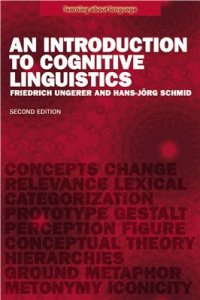
Ebook: An introduction to cognitive linguistics
- Genre: Linguistics // Linguistics
- Tags: Языки и языкознание, Лингвистика, Когнитивная лингвистика и лингвоконцептология
- Language: English
- pdf
2nd ed. — Pearson Education Limited, 2006. — 384 p. — ISBN-13: 978-0-582-78496-3, ISBN-10: 0-582-78496-4.Learning About Language is an exciting and ambitious series of introductions to fundamental topics in language, linguistics and related areas. The books are designed for students of linguistics and those who are studying language as part of a wider course.Cognitive Linguistics explores the idea that language reflects our experience of the world. It shows that our ability to use language is closely related to other cognitive abilities such as categorization, perception, memory and attention allocation. Concepts and mental images expressed and evoked by linguistic means are linked by conceptual metaphors and metonymies and merged into more comprehensive cognitive and cultural models, frames or scenarios. It is only against this background that human communication makes sense. After 25 years of intensive research, cognitive-linguistic thinking now holds a firm place both in the wider linguistic and the cognitive-science communities."An Introduction to Cognitive Linguistics" carefully explains the central concepts of categorization, of prototype and gestalt perception, of basic level and conceptual hierarchies, of figure and ground, and of metaphor and metonymy, for which an innovative description is provided. It also brings together issues such as iconicity, lexical change, grammaticalization and language teaching that have profited considerably from being put on a cognitive basis.The second edition of this popular introduction provides a comprehensive and accessible up-to-date overview of Cognitive Linguistics:
Clarifies the basic notions supported by new evidence and examples for their application in language learning.
Discusses major recent developments in the field: the increasing attention paid to metonymies, Construction Grammar, Conceptual Blending and its role in online-processing.
Explores links with neighbouring fields like Relevance Theory.
Uses many diagrams and illustrations to make the theoretical argument more tangible.
Includes extended exercises.
Provides substantial updated suggestions for further reading.Friedrich Ungerer is Professor of English Linguistics at the University of Rostock, Germany.
Hans-Jorg Schmid is Professor of Modern English Linguistics at the University of Munich, where he has also initiated the Interdisciplinary Centre for Cognitive Language Studies (ICCLS).Contents.
Publisher’s acknowledgments.
Preface to the second edition.
Typographical conventions.
Introduction.
Prototypes and categories.
Colours, squares, birds and cups: early empirical research into lexical categories.
The internal structure of categories: prototypes, attributes, family resemblances and gestalt.
Context-dependence and cultural models.
Levels of categorization.
Basic level categories of organisms and concrete objects.
Superordinate and subordinate categories.
Conceptual hierarchies.
Categorization and composite word forms.
Basic level categories and basic experiences: actions, events, properties, states and locations.
Conceptual metaphors and metonymies.
Metaphors and metonymies: from figures of speech to conceptual systems.
Metaphors, metonymies and the structure of emotion categories.
Metaphors as a way of thinking: examples from science and politics.
Thinking in metonymies: potential and limitations.
Figure and ground.
Figure and ground, trajector and landmark: early research into prepositions.
Figure, ground and two metaphors: a cognitive explanation of simple clause patterns.
Other types of prominence and cognitive processing.
Frames and constructions.
Frames and scripts.
Event-frames and the windowing of attention.
Language-specific framing and its use in narrative texts.
Construction Grammar.
Blending and relevance.
Metaphor, metonymy and conceptual blending.
Conceptual blending in linguistic analysis and description.
Conceptual blending in advertising texts, riddles and jokes.
Relevance: a cognitive-pragmatic phenomenon.
Other issues in cognitive linguistics.
Iconicity.
Lexical change and prototypicality.
Cognitive aspects of grammaticalization.
Effects on foreign language teaching.
Conclusion.
Clarifies the basic notions supported by new evidence and examples for their application in language learning.
Discusses major recent developments in the field: the increasing attention paid to metonymies, Construction Grammar, Conceptual Blending and its role in online-processing.
Explores links with neighbouring fields like Relevance Theory.
Uses many diagrams and illustrations to make the theoretical argument more tangible.
Includes extended exercises.
Provides substantial updated suggestions for further reading.Friedrich Ungerer is Professor of English Linguistics at the University of Rostock, Germany.
Hans-Jorg Schmid is Professor of Modern English Linguistics at the University of Munich, where he has also initiated the Interdisciplinary Centre for Cognitive Language Studies (ICCLS).Contents.
Publisher’s acknowledgments.
Preface to the second edition.
Typographical conventions.
Introduction.
Prototypes and categories.
Colours, squares, birds and cups: early empirical research into lexical categories.
The internal structure of categories: prototypes, attributes, family resemblances and gestalt.
Context-dependence and cultural models.
Levels of categorization.
Basic level categories of organisms and concrete objects.
Superordinate and subordinate categories.
Conceptual hierarchies.
Categorization and composite word forms.
Basic level categories and basic experiences: actions, events, properties, states and locations.
Conceptual metaphors and metonymies.
Metaphors and metonymies: from figures of speech to conceptual systems.
Metaphors, metonymies and the structure of emotion categories.
Metaphors as a way of thinking: examples from science and politics.
Thinking in metonymies: potential and limitations.
Figure and ground.
Figure and ground, trajector and landmark: early research into prepositions.
Figure, ground and two metaphors: a cognitive explanation of simple clause patterns.
Other types of prominence and cognitive processing.
Frames and constructions.
Frames and scripts.
Event-frames and the windowing of attention.
Language-specific framing and its use in narrative texts.
Construction Grammar.
Blending and relevance.
Metaphor, metonymy and conceptual blending.
Conceptual blending in linguistic analysis and description.
Conceptual blending in advertising texts, riddles and jokes.
Relevance: a cognitive-pragmatic phenomenon.
Other issues in cognitive linguistics.
Iconicity.
Lexical change and prototypicality.
Cognitive aspects of grammaticalization.
Effects on foreign language teaching.
Conclusion.
Download the book An introduction to cognitive linguistics for free or read online
Continue reading on any device:

Last viewed books
Related books
{related-news}
Comments (0)